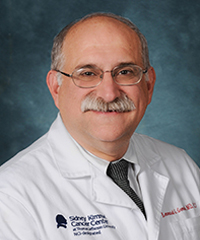Oncology
Prostate Cancer
Combination Therapy and Therapeutic Layering for mCRPC
Overview
Multiple systemic therapies are available for metastatic castration-resistant prostate cancer (mCRPC). These include the chemotherapeutic agents docetaxel and cabazitaxel; androgen-targeting agents abiraterone and enzalutamide; a vaccine, sipuleucel-T; and a radiopharmaceutical, radium-223. Optimal sequencing and combination strategies using these newer agents need to be determined, but there is great hope that the availability of multiple agents with different mechanisms of action will translate to improved outcomes. Here, leading experts describe several important principles in “therapeutic layering” in the treatment of mCRPC.
In the treatment of patients with advanced prostate cancer, do you foresee a move to earlier use of combinations, or perhaps a specific sequence of treatments?
Peter R. Carroll, MD, MPH
|
|
|
Certainly, I do think there will be earlier use of combinations. Some of this is clear, as evidenced by the recent RTOG 9601 demonstrating that, by adding hormonal therapy to radiation in men who fail after surgery, one can improve overall survival, decreasing prostate cancer-specific mortality by about 23%. Again, that approach was generally favored in those men with higher-risk disease and positive surgical margins, but that is a good example of combination therapy having an impact in a disease state where you may have just given them single-modality treatment. Not all people benefit from the combinations, but some certainly do. And then additional examples include the CHAARTED (ChemoHormonal therapy vs Androgen Ablation Randomized Trial for Extensive Disease in prostate cancer) and STAMPEDE (Systemic Therapy in Advancing or Metastatic Prostate cancer: Evaluation of Drug Efficacy) trials, with the use of docetaxel in combination with androgen depravation; and, more recent reporting on the use of abiraterone from the LATITUDE and STAMPEDE trials. |
|
Leonard Gomella, MD
|
|
|
One of the few points that the literature has supported so far in regard to sequencing, I think, relates to patients who are likely to respond best to sipuleucel-T, ie, those with minimally symptomatic or asymptomatic mCRPC. At the moment, once you get beyond sipuleucel-T, it becomes almost a “dealer’s choice” as to which agent you use. Although, if the patient presents with very severe symptoms, many of our colleagues will go right to a chemotherapy regimen, such as docetaxel, or to radium-223. Patients today do not present as often with the prominent metastatic symptomology (eg, the hip fracture or cord compression) that was more common years ago. So, I think that beyond minimal disease, with sipuleucel-T being one of those agents that you might want to think about first, everything else after that – unless you are really severely symptomatic – is really coming down to whether somebody wants to use abiraterone or enzalutamide or radium-223 or docetaxel or other agents. It’s really up to the individual clinician and their comfort level in conjunction with the patient and individual characteristics of the patient. |
|
“At the moment, once you get beyond sipuleucel-T, it becomes almost a ‘dealer’s choice’ as to which agent you use.”
E. David Crawford, MD
|
|
|
As Dr Gomella just said, when somebody presents with mCRPC, it opens up the door for all of these newer drugs. So, how do you layer them? Well, there are some really good data to support layering with more than just one agent. Sipuleucel-T, if you get that in early, we’ve shown that if your prostate-specific antigen (PSA) is <20 ng/mL, then you have a 13-month survival benefit. And you can add abiraterone to that, and add enzalutamide to that, and you can start compounding these benefits. Radium-223 is unique: it’s an alpha particle, which is very large; it’s the only radiopharmaceutical to show an improvement in survival rate in mCRPC; and it’s not just for patients who are writhing in bone pain at the end of the line. The approval by the US Food and Drug Administration is not simply to reduce pain. It’s also for bone disease and improving outcomes – so that should be earlier. There is a lot of excitement right now about these new drugs. Survival rates for advanced and castrate-resistant disease are increasing significantly. I may be an optimist, but one day, with all these new drugs, maybe we would be able to convert to a chronic disease, like diabetes and heart disease – we don’t cure it, but we treat it. And I think that is something that could come to fruition in not too long a period of time. |
|
“Radium-223 is unique: it’s an alpha particle, which is very large; it’s the only radiopharmaceutical to show an improvement in survival rate in mCRPC; and it’s not just for patients who are writhing in bone pain at the end of the line. It’s also for bone disease and improving outcomes – so that should be earlier.”
Neal D. Shore, MD, FACS
|
|
|
As it relates to someone developing asymptomatic M1 CRPC, where there is radiographic evidence of disease, I have a shared patient-physician discussion regarding the uses of the approved therapies, in concert with guidelines by the National Comprehensive Cancer Network (NCCN) and American Urological Association (AUA). And the decision is predicated upon the location and volume of the disease, the patient’s comorbidities, his overall actuarial survival, and then any other particular nuanced aspects of his health history. So, there could be the possibility of sipuleucel-T, abiraterone acetate, enzalutamide, and radium-223, as well as docetaxel. There are various types of nomograms that people have used over time, but in my real-world practice, I do not routinely use a nomogram or an algorithm to have my decision-making discussion with my M1 CRPC patients. I first and foremost want to know the volume and location of their metastatic disease (ie, bone, soft tissue, visceral) and whether or not they are symptomatic from cancer-related pain or other metastasis-related symptomatology. I want to know any other significant comorbidities regarding their cardiovascular, renal, and hepatic metabolism, and I want to understand not only their chronologic age but also their biologic age, with a view toward their actuarial survival. |
|
“There are various types of nomograms that people have used over time, but in my real-world practice, I do not routinely use a nomogram or an algorithm to have my decision-making discussion with my M1 CRPC patients.”
These factors will always enter into a discussion with patients, and I always outline all of the approved therapies as well as clinical trials that we have – because I am a very strong proponent of clinical trials – which is why we have this embarrassment of riches: 6 therapies that are life-prolonging now approved essentially world-wide since 2010.
The challenge in selecting the right therapy for the right patient at the right time is that we still have an imperfect understanding of all of this, in that we need to conduct prospective sequencing and combinatorial trials in a way that will give us additional information. Many of these trials are ongoing. The challenge is, when you have a patient who has a terminal disease such as M1 CRPC, you have to make decisions now. So, this is the basis for the physician-patient shared decision-making: reviewing the risks and benefits of specific therapies, reviewing the overall phenotype of the patient’s disease, rating the aggressiveness of the disease, and identifying the patients’ own personal expectations for maintenance of quality of life.
References
Crawford ED, Petrylak DP, Shore N, et al. The role of therapeutic layering in optimizing treatment for patients with castration-resistant prostate cancer (prostate cancer radiographic assessments for detection of advanced recurrence II) [RADAR II]. Urology. 2017;104:150-159.
Fizazi K, Tran N, Fein L, et al. Abiraterone plus prednisone in metastatic, castration-sensitive prostate cancer. [LATITUDE] N Engl J Med. 2017;27;377(4):352-360.
James ND, de Bono JS, Spears MR, et al. Abiraterone for prostate cancer not previously treated with hormone therapy. [STAMPEDE]. New Engl J Med. 2017;27;377(4):338-351.
James ND, Sydes MR, Clarke NW, et al. Addition of docetaxel, zoledronic acid, or both to first-line long-term hormone therapy in prostate cancer [STAMPEDE]: survival results from an adaptive, multiarm, multistage, platform randomised controlled trial. Lancet. 2016;387(10024):1163-1177.
Shipley WU, Seiferheld W, Lukka HR, et al. Radiation with or without antiandrogen therapy in recurrent prostate cancer. [RTOG 9601] N Engl J Med. 2017;376(5):417-428.
Sweeney CJ, Chen YH, Carducci M, et al. Chemohormonal therapy in metastatic hormone-sensitive prostate cancer. [CHAARTED] N Engl J Med. 2015;373(8):737-746.














